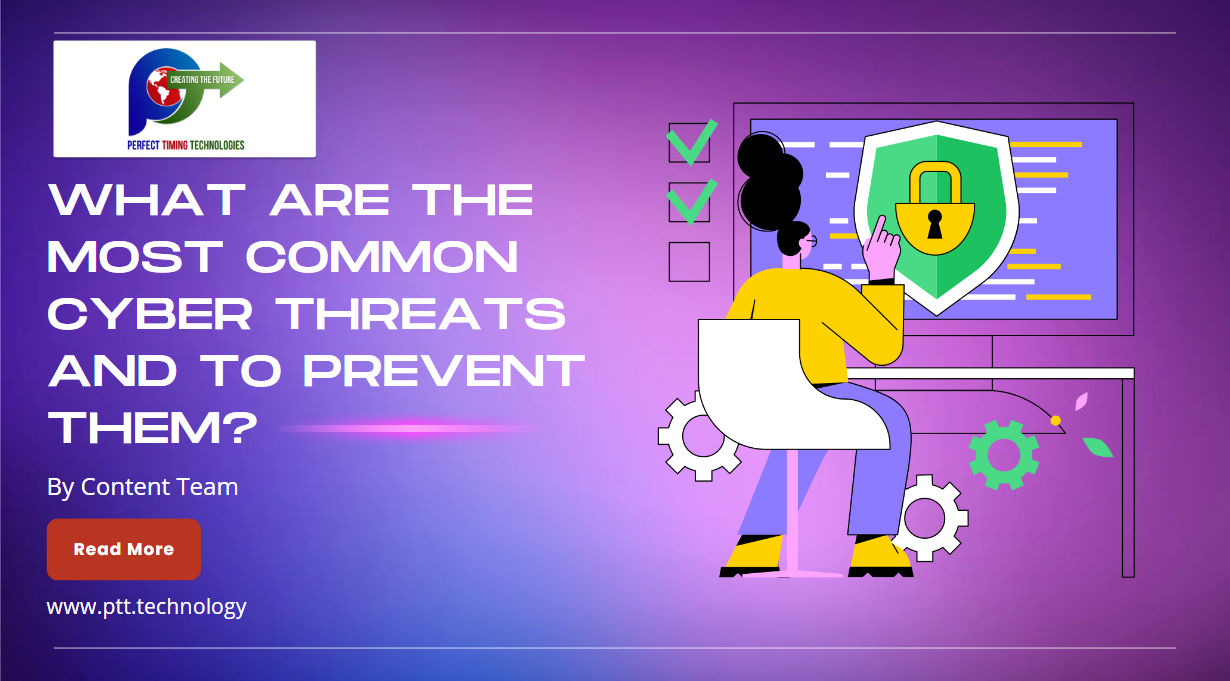
Modern businesses face many challenges in their day-to-day operations. However, the most common threat businesses are prone to be cyber-based. On average, almost 2200 cybersecurity incidents take place every day.
Technological advancements have increased the chances of cyber attacks and the potential to use them illegally. The invention of IoT has got all the attention of cybercriminals. Nevertheless, having a good awareness of various aspects of cybersecurity can help organizations prevent such attacks.
Today we will delve into the four most common types of cyber threats and some effective preventive measures.
FOUR COMMON TYPES OF CYBER THREATS
Let’s briefly discuss the most common types of cyber threats.
- MALWARE: Malware is an umbrella term to describe any software or code deliberately designed to cause harm to a computer system, network, or device. Malware can take many forms, including viruses, worms, Trojans, ransomware, spyware, adware, and rootkits. Malware spreads through various means, including email attachments, software downloads, compromised websites, and infected removable media such as USB drives. Once installed on a computer or device, malware can damage files, steal sensitive information, hijack computing resources, or take control of the entire system.
Protecting against malware requires antivirus and anti-malware software, keeping the software and operating systems updated with security patches, being cautious when opening email attachments or downloading software from the internet, and regularly backing up important files.
- TROJAN HORSE VIRUS: A Trojan horse virus called a “Trojan” is a type of malware that disguises itself as legitimate software or files to trick users into downloading or executing it. Once a Trojan installs on a computer, it can perform a wide range of malicious activities, including stealing personal information, corrupting files, disabling the security software, and allowing unauthorized access to the computer.
Unlike viruses or worms, Trojan horses do not self-replicate or spread automatically. Instead, they rely on users to download and execute them, often by disguising themselves as harmless files such as documents or images. Trojans can get transferred through email attachments, peer-to-peer file sharing, or by exploiting vulnerabilities in web browsers or other software.
Trojan horse viruses threaten computer security and can cause significant damage to individual users, businesses, and even entire networks. Users can protect themselves from Trojans by using reputable antivirus software, keeping their operating systems and software updated with security patches, and being cautious about downloading files from unknown sources.
- PHISHING ATTACK: Phishing is a cyber threat where an attacker attempts to trick users into providing sensitive information as login credentials, credit card details, or personal information, by impersonating a trustworthy entity or organization. Phishing attacks can be carried out through email, social media, or messages and often involve creating fake websites or login pages that closely resemble legitimate ones.
Phishing attacks typically work by luring the user into clicking a link or opening an attachment that appears to be from a trusted source, such as a bank, social media site, or email provider. Once the user clicks the link or enters their information into the fake website, the attacker can use that information for theft, steal the user’s identity, or launch further attacks.
Phishing attacks can be very effective, as they rely on social engineering and psychological manipulation to trick users into divulging sensitive information. To protect against phishing attacks, users should be cautious about clicking links or downloading attachments from unknown sources, verify the authenticity of login pages and websites by checking the URL and the security certificate, and use multi-factor authentication whenever possible. Additionally, organizations should implement security measures such as spam filters, employee training, and network monitoring to prevent and detect phishing attacks.
- RANSOMWARE ATTACK: Ransomware is malicious software designed to block access to a computer system or files until a ransom is paid. This malware typically encrypts the victim’s data, making it inaccessible, and demands payment against a decryption key to unlock the data.
Ransomware attacks are done through various methods, such as phishing emails, malicious software downloads, or exploiting vulnerabilities in a computer system’s security. Once the ransomware infects a computer system, it will display a message to the victim demanding payment as a cryptocurrency.
Ransomware attacks can have severe consequences, that includes loss of sensitive data, the disruption of critical systems, and financial losses. It’s essential to take to prevent ransomware attacks, such as keeping software up-to-date, avoiding suspicious email attachments or links, and regularly backing up important data.
Tips to Prevent Cyber Threats
Cyber security is essential for an organization’s overall security. Here are a few tips to help you protect your business data and systems from cyber threats.
- Remain cautious while using the Internet. Keep your organization’s systems updated, use pop-up blockers, and never fall prey to free software.
- Always use anti-malware software to scan external storage devices before plugging them into your computer system.
- Remember, websites do not ask for personal information from visitors. Utilize phishing filters while browsing the web and enter the URL instead of directly clicking on the link.
- You must train your employees to identify and stop cyber attacks. Moreover, information security controls must be integrated into the systems to secure business data.
Final Thoughts
Appropriate knowledge is necessary to keep your computer systems protected from cyber threats. You must invest in training your employees to identify, handle, and report various cyber threats.
Install firewalls and antivirus software to win against cyber threats.







